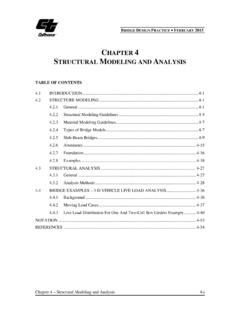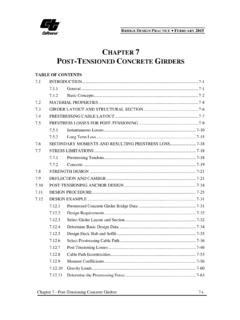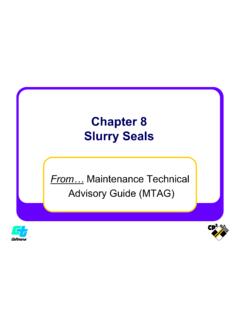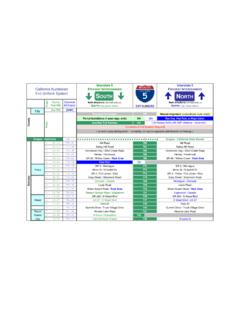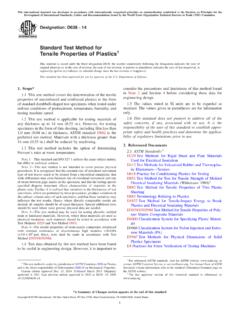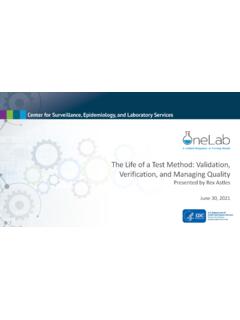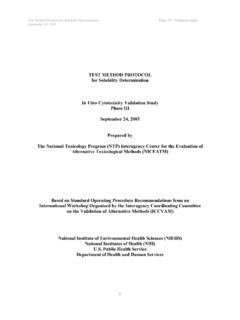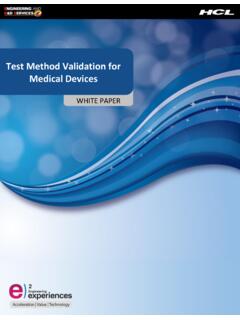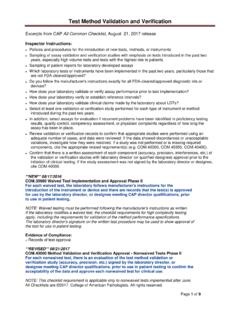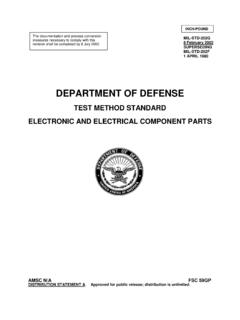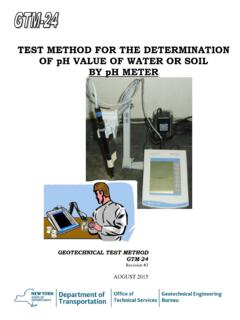Transcription of METHOD OF TEST FOR SIEVE ANALYSIS OF FINE AND …
1 California Test 202 STATE OF CALIFORNIA BUSINESS, TRANSPORTATION AND HOUSING AGENCY November 2011 DEPARTMENT OF TRANSPORTATION DIVISION OF ENGINEERING SERVICES Transportation Laboratory 5900 Folsom Boulevard Sacramento, California 95819-4612 METHOD OF TEST FOR SIEVE ANALYSIS OF FINE AND COARSE AGGREGATESA. SCOPE This METHOD , which includes modifications of AASHTO Designations T 11, T 27, T 30, and T 37, specifies the procedures for determining the particle-size distribution of fine and coarse aggregates. Special procedures for testing aggregate from extracted bituminous mixtures, supplemental fine aggregate, glass spheres, and granular quicklime are included in Appendices A, B, C, and D, respectively. A procedure for expediting testing and providing an approximate particle-size distribution for processed fine aggregate is included in Appendix E.
2 B. REFERENCES California Test 201- Soil and Aggregate Sample Preparation AASHTO M 92 - Standard Specification for Wire-Cloth Sieves for Testing Purposes AASHTO T 11 - Test for Materials Finer Than 75- m (No. 200) SIEVE in Mineral Aggregates by Washing AASHTO T 27 - Test for SIEVE ANALYSIS of Fine and Coarse Aggregates AASHTO T 30 - Test for Mechanical ANALYSIS of Extracted Aggregate AASHTO T 37 - Test for SIEVE ANALYSIS of Mineral Filler for Hot Mix Asphalt (HMA) C. APPARATUS 1. Balance: A balance or scale reading to 1 g for samples weighing less than approximately 1,000 g. For samples weighing more than 1,000 g the balance or scale should read to % of the test sample s mass. 2. Sieves: Woven-wire cloth sieves of 3 in., 2 in., 2 in., 1 in., 1 in., in., in., 3/8 in., in., No. 4, No. 8, No. 16, No. 30, No.
3 50, No. 100, and No. 200 designations with square openings conforming to AASHTO Designation M 92. a. Each SIEVE shall be inspected visually for bent or distorted wires after each use. Replace any damaged or nonconforming sieves. 3. SIEVE shaker: Any mechanical SIEVE -shaking device that accomplishes the same thoroughness of sieving as the hand-sieving procedure described in of this METHOD . a. It is essential that the SIEVE shaker be designed so that its motion includes a bumping or bouncing action sufficient to keep the aggregate particles in motion on the surface of the sieves. California Test 202 November 2011 2 b. Refer to Section of this METHOD for procedures to verify shaker efficiency. 4. Agitator (Figure 1): A mechanical device designed to hold the wash vessel in an upright position while subjecting it to a lateral reciprocating motion at a rate of 285 10 complete cycles per minute.
4 The reciprocating motion shall be produced by means of an eccentric located in the base of the carrier, and the length of the stroke shall be in. in. The clearance between the cam and follower of the eccentric shall be between in. and in. Other types of agitators may be used provided the length of time and other factors are adjusted to produce the same results as those obtained using the agitator described above. 5. A combination SIEVE shaker-agitator is allowable when it meets the above requirements for shaking ( & b) while in the shaking mode and agitation (4) while in the agitation mode. A Tyler portable SIEVE shaker meets the above requirements when modified according to TL drawing No. D536. 6. Mechanical Washing Vessel: A flat-bottom, straight-sided, cylindrical vesselconforming to the specifications and dimensions shown in Figure 2.
5 7. An oven or other suitable thermo-statically controlled heating device capable of maintaining a temperature of 230 F 9 F. D. MATERIALS Distilled, deionized, or good-quality tap water shall be used for washing the fine-aggregate test sample. E. SIZE OF SAMPLE 1. The sample to be tested shall be of sufficient size to ensure representation of the material. The exact amount of material required will vary according to the nominal size of the aggregate and the particle-size distribution. 2. Recommended sample mass for each aggregate size of processed aggregates (such as sized aggregates for PCC and AC) or composite aggregates (such as AB and CTB) that are comprised of approximately 40 % or more of aggregate retained on the No. 4 SIEVE , are listed in Table 1. TABLE 1 Maximum Nominal Aggregate Size Recommended Mass of Portion Retained on No.
6 4 SIEVE Over 2 in. 30,000 g 2 in. 25,000 g 2 in. 20,000 g 1 in. 15,000 g 1 in. 10,000 g 3/4 in. 5,000 g in. 2,500 g 3/8 in. 1,000 g California Test 202 November 2011 3 3. Sample size, for materials not adaptable to the recommendations in paragraph 2,should be sufficient to yield the amounts noted below for each coarse-size fraction that makes up 5 % or more of the total sample. a. At least 1,000 g of coarse-size fractions equal to or larger than in. b. At least 500 g of coarse-size fractions smaller than in. 4. Samples containing more than 15 % passing the No. 4 SIEVE shall be of sufficient size to yield at least 1,000 g of material passing the No. 4 SIEVE . F. SIEVING PROCEDURE 1. Separate the test sample into a series of sizes using such sieves as are necessary to determine compliance with the specifications for the material being tested.
7 Either the hand or mechanical sieving METHOD may be used. a. Perform the hand METHOD of sieving by means of a lateral and vertical motion of the SIEVE , accompanied by a jarring action, so as to keep the sample moving continuously over the surface of the SIEVE . Do not turn or manipulate particles through the SIEVE by hand. Continue sieving until not more than % by mass of the total sample will pass any SIEVE during one additional minute of hand sieving. b. Mechanical sieving may be used only after it has been demonstrated that the shaker will separate a test sample with the same effectiveness as the hand METHOD . The effectiveness of the mechanical shaker and the minimum shaking time shall be determined for each shaker by comparison with the hand-sieving METHOD using the procedure described below. (1) Obtain a test sample of all crushed, clean, durable aggregate with a relatively uniform size distribution over the range of sieves to be included.
8 (2) Determine the total mass of the test sample and the tare mass of each SIEVE . (3) Separate the sample into its various SIEVE sizes using the mechanical shaker operated for a trial period. (4) At the end of the trial period, determine the amount of material retained on each SIEVE by weighing the sieves and retained material and subtracting the mass of the SIEVE . (5) Reassemble the sieves in the mechanical shaker, and shake for an additional period of time of not less than 1 min. (6) Determine the amount of material on each SIEVE as in step (4). (7) Repeat steps (4) through (6) until not more than % by mass of the total sample passes through any of the sieves during the additional shaking time. (8) SIEVE each size fraction for one additional minute using the hand- sieving procedure. California Test 202 November 2011 4 (9) If more than % by mass of the total sample passes through any SIEVE during the hand sieving, the mechanical shaker is not performing effectively, and it shall not be used.
9 (10) The required shaking time for the shaker shall be at least 125 % of the minimum time required to accomplish the thoroughness of sieving described above. In no case shall the shaking time for any shaker be less than 5 min. c. When sieving, limit the amount of material retained on the No. 4 and coarser sieves to a single layer of aggregate. If necessary, SIEVE the test sample in portions; then combine all respective portions retained on the sieves before weighing. d. In no case, when sieving fine aggregate (material passing the No. 4 SIEVE ),shall the material retained on any SIEVE at the completion of the sievingoperation exceed that mass specified in Table reduce the amount ofmaterial retained on a SIEVE , either use a SIEVE with openings slightly largerthan the overloaded SIEVE , or split the entire sample into smaller portions prior to sieving, and then combine respective fractions prior to weighing.
10 TABLE 2 MAXIMUM MASS IN GRAMS OF MATERIAL ALLOWED ON SIEVE * AT COMPLETION OF SIEVING OPERATION SIEVE Size Wt. Per TotalMass for8 in. DiameterSieve No. 8 200 16 150 30 125 50 100 100 75 200 50 *For intermediate SIEVE sizes not listed in this table, the mass specified for the next smaller SIEVE size shall apply. G. DETERMINATION OF COARSE-AGGREGATE PARTICLE-SIZE DISTRIBUTION 1. Prepare all materials as prescribed in California Test 201. Be sure to clean all coatings from the coarse aggregate and break clods sufficiently to pass the No. 4 SIEVE . 2. If the coarse-aggregate particles contained in a sample are clean or are coated lightly with fines, which can be removed easily by sieving, it will not be necessary to subject the coarse portion to a cleaning process prior to performing the coarse- SIEVE separation.
